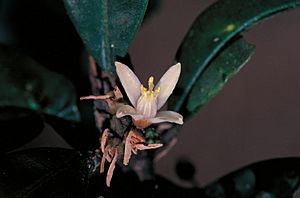Medicosma sessiliflora facts for kids
Quick facts for kids Medicosma sessiliflora |
|
|---|---|
 |
|
| Conservation status | |
| Scientific classification | |
| Genus: |
Medicosma
|
| Species: |
sessiliflora
|
| Synonyms | |
|
|
Medicosma sessiliflora is a special kind of shrub or small tree. It belongs to the Rutaceae family, which also includes citrus fruits like oranges and lemons! This plant is only found in far north Queensland, Australia. It has simple leaves that are shaped like an oval or an egg. Its pretty cream-colored flowers grow alone or in small groups where the leaves meet the stem.
Contents
What it Looks Like
Medicosma sessiliflora is usually a shrub or a small tree. It can grow up to about 10 meters (about 33 feet) tall.
Leaves and Flowers
The leaves are shaped like an oval or an egg. They are wider at the top and narrower at the bottom. These leaves can be from 5.5 to 22.5 centimeters (about 2 to 9 inches) long. They are about 2 to 8.5 centimeters (about 0.8 to 3.3 inches) wide. Each leaf has a stalk called a petiole, which is 0.5 to 4.5 centimeters (about 0.2 to 1.8 inches) long.
The flowers grow alone or in small groups. Each flower is very small, about 12 millimeters (less than half an inch) long. They either grow directly on the stem (this is called sessile) or on a tiny stalk called a pedicel. This tiny stalk is usually less than 1 millimeter long.
The flowers have small green parts called sepals, which are 1 to 2 millimeters long. The main parts of the flower are the petals, which are cream-colored. They are 5 to 7 millimeters long. The back of the petals is covered with soft hairs. Inside the flower, there are eight stamens, which are the parts that produce pollen. These stamens are different lengths.
Reproduction and Fruit
Medicosma sessiliflora flowers from May to November. After flowering, it produces a fruit called a follicle. This fruit is 5 to 10 millimeters long.
How it Was Named
This plant was first officially described in 1936. A scientist named Cyril Tenison White gave it the name Melicope sessiliflora. He wrote about it in a science paper called Proceedings of the Royal Society of Queensland. The plant samples he studied were collected by Leonard John Brass in the Mossman Gorge.
Later, in 1985, another scientist named Thomas Gordon Hartley changed its name. He renamed it Medicosma sessiliflora in the Australian Journal of Botany.
Where it Lives
Medicosma sessiliflora grows in rainforests. You can find it from sea level up to an altitude of 750 meters (about 2,460 feet). It grows in far north Queensland, from near Cooktown all the way to the Atherton Tableland.
Conservation Status
The Queensland Government has a list of plants and animals. They classify Medicosma sessiliflora as a species of "least concern." This means that, for now, there are enough of these plants in the wild, and they are not in immediate danger of disappearing.


